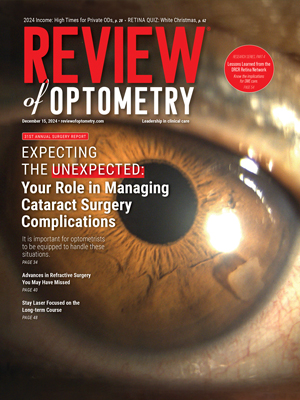In the last several decades, numerous multifocal and monovision contact lenses have become available for patients with presbyopia. A new study published in Contact Lens & Anterior Eye charted international trends in these lens fittings over the last 24 years and found that since 2000, multifocal and monovision soft lens prescribing to presbyopes has increased nearly twofold.
Each year since 2000, an annual contact lens prescribing survey has been distributed to eyecare practitioners in up to 71 countries. For the present study, the authors were able to derive longitudinal data on 52,580 presbyopia fits from 20 countries. All presbyopes fitted with contact lenses were aged 45 or older.
The results indicated a significant shift in the prescribing practices for correcting presbyopia with contact lenses in the last quarter century. There was more than a doubling in the rate of these prescriptions, from 26.4% of standard soft daily wear lens fits in 2000 to 61.1% in 2023.
| Based on data from eyecare practitioners across 20 countries, multifocal contact lens fittings for presbyopes peaked between ages 50 to 65 and then steadily dropped off until age 90. Meanwhile, monovision lens fittings for presbyopes steadily increased until the age group of 75 to 80 years and then fell steeply until 90 years of age. Photo: Morgan PB, et al. Cont Lens Ant Eye. December 6, 2024. Click image to enlarge. |
Unsurprisingly, multifocal lens fittings peaked between ages 50 to 65. Beyond age 65, the researchers noticed a decline in multifocal lens fittings accompanied by an increase in monovision fittings, which they explained in their paper “may indicate some disillusionment with multifocal lenses and a willingness to try monovision correction” among this age group. However, beyond 90 years of age, multifocal lenses became more popular again, which could possibly be due to “an increasingly pseudophakic demographic with a renewed visual ability and interest in achieving good vision at all distances,” the researchers suggested.
The data analysis also underscored slight differences in gender with respect to these fittings; on average, 45.1% of all soft daily lens fits among male presbyopes involved multifocal or monovision lenses, compared to 52.7% among female presbyopes, which researchers believe “may reflect a stronger desire among females for the cosmetic advantage of using a less conspicuous form of refractive correction.”
Fittings also varied between countries based on geographical and possibly cultural differences; for instance, Spain showed a consistently higher rate of presbyopia lens fittings across the 24 years than Taiwan and Japan.
Providing a more recent snapshot of presbyopia fitting trends, the authors reported that from 2019 to 2023, multifocal lenses accounted for 51% of the fits, monovision for 10% and other forms of correction for 39%, although this breakdown varied between countries; as one example, monovision was especially popular in New Zealand (27 %), Australia (22 %) and the United States (22%).
In their paper on the survey findings, the authors explained, “Reasons for the increase in presbyopia lens fitting between 2000 and 2018 include the following: (1) a greater number of multifocal lens types and brands gradually becoming available, (2) an increase in the range of available parameters (primarily add powers and toric lens forms), and (3) the development of improved optical designs offering more acceptable visual performance compared with previously available lenses.” They also noted that presbyopia fittings have remained relatively stable since 2018, which “is presumably due to ‘market saturation’, whereby a near-full range of parameters of multifocal lenses was becoming available.”
Although prescriptions for multifocal and monovision soft contact lenses have risen significantly over the surveyed years, “a substantial proportion of presbyopic soft contact lens wearers (39%) are currently being fitted with a distance correction only and are presumably relying upon the use of reading spectacles (worn over their contact lenses) for close work,” the researchers explained. They offered a host of reasons why this may be the case, such as patients’ unwillingness to accept the visual compromises of multifocal and monovision lenses, distance vision concerns for eyes with smaller pupils, practitioner misconceptions and the potential high cost associated with multifocal lenses.
“The barriers to presbyopia lens fitting outlined above could be overcome by enhancing professional education in theoretical and technical aspects of multifocal and monovision contact lens fitting,” the study authors suggested before concluding, “Further growth in this sector can be nurtured by continued research and development into optimized multifocal contact lens optics and design.”
| Click here for journal source. |
Morgan PB, Efron N, Woods CA, et al. International trends in prescribing multifocal and monovision soft contact lenses to correct presbyopia (2000–2023): An update. Cont Lens Ant Eye. December 6, 2024. [Epub ahead of print]. |


